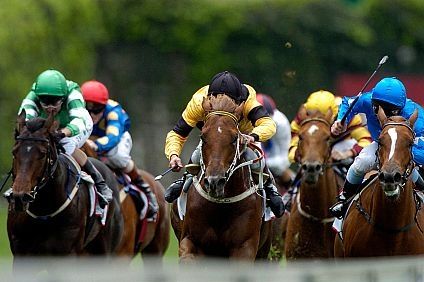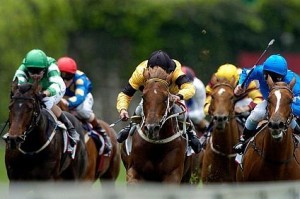Horse Racing Explained
Written by Jay Kellegrew (follow him on twitter @hellonewman39)
When some people step off the plane at McCarran airport, they see nothing but bright lights and hope. They head to the sportsbook and check out the slate of NBA and NHL playoff matchups while also pretending to have a firm grasp of who every starter is in each baseball game. However, they completely ignore the other half of the sportsbook where people speak a foreign language about trifectas, maidens, and mudders. My goal here isn’t to make you a handicapping wizard but rather help provide a basic guide to pari-mutuel betting, the kind employed through all Vegas casinos and most of your local off track betting facilities.
First, let’s talk about the types of wagers that can be made. The wagers are split into two categories; straight wagers and exotic wagers.
Straight wagers
Win – picking which horse will win the race
Place – picking a horse that will come in 1st or 2nd
Show – picking a horse that will come in the top 3
Exotic wagers
Exacta – predicting the first 2 horses in exact order
Trifecta – predicting the first 3 horses in exact order
Superfecta – predicting the first 4 horses in exact order
Win and Place pools explained
Unlike the other side of the sportsbook where lines are fixed as soon as the ticket is in your hand, pari-mutuel odds change right up until the start of the race because final prices aren’t determined until the final pool is calculated . You are competing against your fellow gamblers; the house merely takes a cut of all money that is bet. For example, let’s say a total of 1 million dollars (after the house cut) was bet on all the horses to win in a race. Once the race is over, it turns out the race winner had bets totaling $100,000 on him to win. This means that for every $1 bet on that horse, $10 is available in the win pool of money. Therefore, you would win $9 on every $1 bet (plus get returned your original bet), and this horse’s final odds would pay at 9 to 1.
The place pool is a little more complicated. Let’s say $100,000 (after the house cut) was bet on horses to place in a race. That means $50,000 will go to people who bet the winning horse to place, and $50,000 will go to the people that bet the 2nd place horse to place. If the winner was a heavy favorite and $25,000 was bet on him to place, the payout would be 1 to 1. If the 2nd place horse was a long shot and only had $1,000 bet on him place, then that would pay $49 for every $1 bet or 49 to 1. (Yes I know this may be more horse racing math than you ever wanted to know but bear with us!)
Placing your Bets
Knowing what the betting options are is half the battle; placing them is the other. Just like at the sportsbook, there is a proper procedure to follow. First, state the name of the track and which number race of the day you would like to bet on (Example 3rd race at Pimlico). Then, state the amount of money you would like to wager (usually $2 is the minimum bet on straight bets and $1 on exotics) and which type of wager you are making ($5 to place). Finally state the horse number or numbers you are betting (horse 6). You can walk confidently to the window and say, “In the 3rd race at Pimlico today I’ll wager 5 dollars to place on the 6 horse.”
Trying to place exotic wagers is slightly more challenging than looking at straight bets. It’s rare that bettors only bet 1 single combination since the odds often make it conducive to trying different permutations. It is more likely that they find 3 or 4 horses they feel have a good chance to do well in the race and the goal is to cover all options. The end result is using a term called a “box.” An example of how to place this wager: “In the 8th race at Belmont Park, I’ll do a $2 trifecta box on horses 1, 4, and 6.” This bet will cost you more than $2 because it is a bet of $2 on every combination of those horses coming in the top 3: 1-4-6, 1-6-4, 4-1-6, 4-6-1, 6-1-4 and 6-4-1 would all be listed on your ticket so you have actually made 6 different $2 bets for $12 in total.
Feeling a little more confident? Another option is to bet what is called a “wheel” where you specify which horses you want to bet in each position. For example, a superfecta wheel could look like this, “In the 6th race at Churchill I’ll take a $1 superfecta wheel with 2 and 3 on top of 2 and 3 on top of 1 and 4 on top of 1 and 4.” In this scenario the bettor has basically said they think the 2 and 3 horses will come in 1st and 2nd in some order and the 1 and 4 horses will come in 3rd and 4thin some order. They have covered the combinations 2-3-1-4, 2-3-4-1, 3-2-1-4 and 3-2-4-1, so the ticket will cost $4. Adding more horses to boxes and wheels will give you more chances to win, but can increase the price dramatically as the number of combinations grows. (If you don’t understand this concept, don’t feel bad since I think even Todd who works in the industry was lost during this portion of the article)
With that knowledge under your belt, you can now walk the walk at the pari-mutuel window. The Belmont is a few weeks away and given that I’ll Have Another will be making a push to be our first triple crown winner since 1978, it offers a great opportunity to place your first bets. Betting on horse racing is legal across the country so you can still get bets down at your local track while you wait to return to the desert. As for the handicapping part of the program, well knowing the terminology when you get to the window is half the battle, finding actual winners will always remain the challenge.













